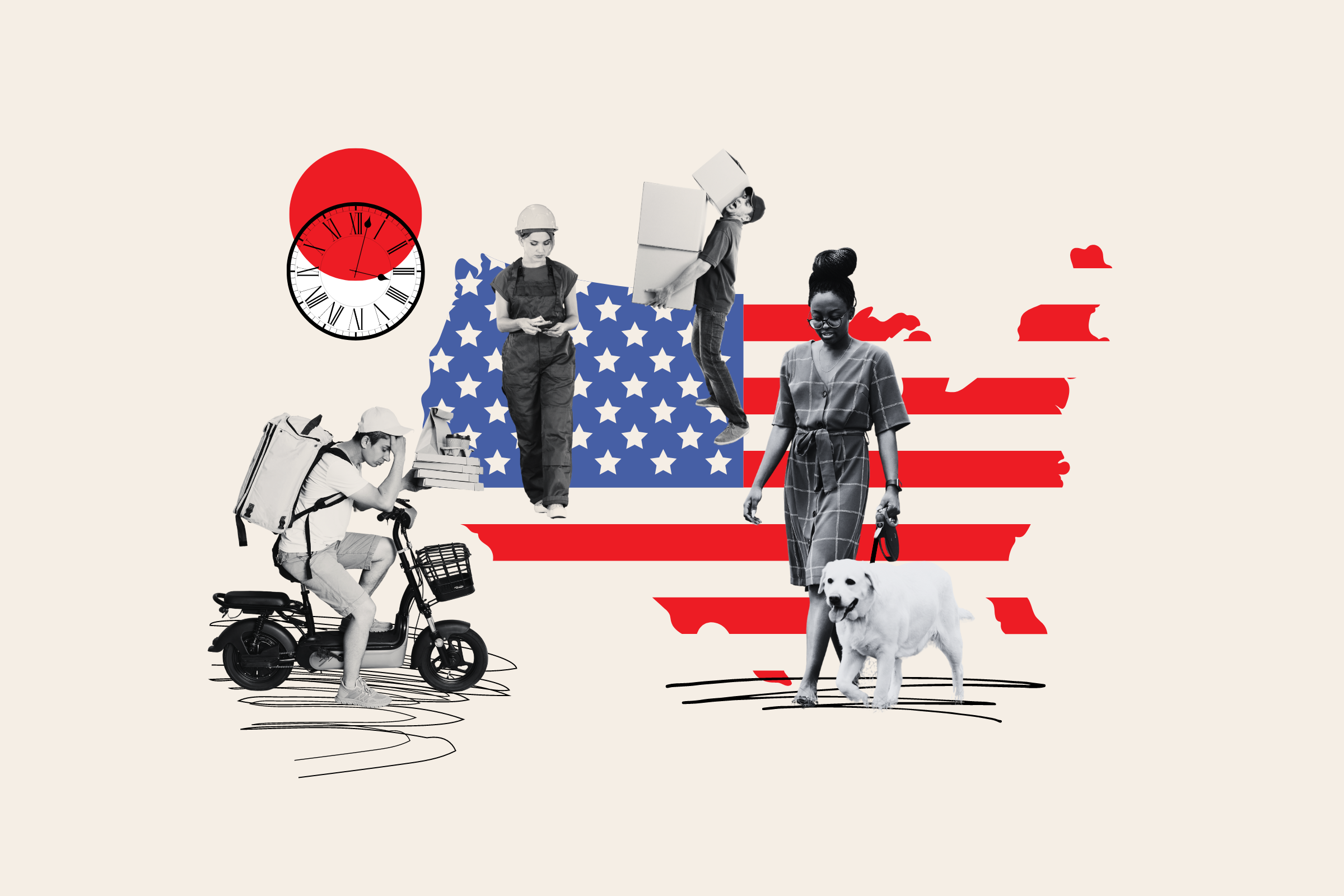Uncommon Knowledge
Newsweek is committed to challenging conventional wisdom and finding connections in the search for common ground.

Millions of Americans are working for the weekend—the one that never comes.
Matthew Kallish, 45, of Oak Ridge, New Jersey, labors up to 50 hours weekly as a U.S. Postal Service (USPS) rural carrier associate, starting shifts at 7:30 a.m. that last until his route gets fully served, sometimes as many as six days each week.
The married father also works a second job as a night auditor at a hotel in Parsippany, managing the property on weeknights from 11 p.m. to 7 a.m., leaving Kallish little time to enjoy the fruits of his exertion.
“It’s been tough for sure,” Kallish told Newsweek of the grueling schedule he’s endured for more than 2 1/2 years. “Working the two jobs has definitely impacted my family in many ways.”
Kallish’s grit helps afford his family occasional luxuries, but the devoted dad primarily needs to rest whenever he does get home, leaving chores and other responsibilities for his sons, 16-year-old Shaun and 10-year-old Michael, as well as his wife, Tania, 43, who also works full time in real estate.
“It has been a rough couple of years with two jobs,” he said. “My sleep schedule is all over the place and I am lucky if I get 3-4 decent hours of sleep a night.”
Personal debt, high cost of living and raising two active boys led Kallish to find another gig. He’s among 36 percent of Americans who rely on second jobs or side hustles to make ends meet, according to a survey released last month.
Roughly one-third of respondents also believe they’ll always need second gigs to keep themselves financially afloat. Kallish foresees a few more years in his current schedule but hopes to cut back his hours at the hotel once becoming a full-time USPS mail carrier.

“I know there is a light at the end of the tunnel, and we are getting closer to it every day,” he said.
Ted Rossman, senior industry analyst at Bankrate, which conducted the survey in June, said the current share of Americans with side hustles is slightly down from last year’s all-time high of 39 percent, but still a sizable jump from 2017, when 19 percent of U.S. adults reported one or more jobs.
“So that’s a big part of the story—the fact that roughly twice as many people are side-hustling now as were back in 2017, Rossman told Newsweek. “I attribute a lot of that to inflation, high interest rates and people just needing extra money to make ends meet.”
Recent advances in connectivity have helped those looking for extra shifts, but there’s a definite risk of “burnout,” even to those pursuing passion projects or building new skills, Rossman said.
“Not that 2017 was the Dark Ages in terms of a lack of technology, but it has gotten easier with things you can do from home and online and through apps,” he said. “There’s also the question of what this says about the economy and the job market.”

Despite the unemployment rate rising slightly to 4.1 percent in June and its longest stretch below 4 percent since the 1960s ending in May, Rossman said the economy has largely enjoyed solid wage growth and increased consumer spending.
“All that’s been pretty good,” Rossman continued. “Now none of this feels good because people are stressed by inflation and that’s really gobbling up a lot of the nominal gains they’re making. So that’s where I really feel like it comes back in many respects to a cost-of-living story.”
Dr. Sue Varma, psychiatrist and author of Practical Optimism: The Art, Science and Practice of Exceptional Well-Being, said she was dismayed by the data.
“These statistics give us further context to why so many young people are feeling demoralized right now and feeling as if any number of financial milestones—savings, home buying, investments, leisure, retirement—are off the table for them,” Varma told Newsweek. “The current economic climate strips young people of their hope, agency and natural predisposition towards optimism—something I see in my practice with people throughout the lifecycle, but especially in younger people.”

Roughly half (48 percent) of respondents ages 18-27 reported having side hustles—the highest of any age bracket—followed by millennials (44 percent), Generation X (33 percent) and baby boomers (23 percent), according to the study.
“The new normal involves having 1-2 side hustles,” Varma said. “And it’s becoming—fortunately or unfortunately—an accepted part of our culture, almost like a badge of honor for some.”
Having a second (or third) gig often makes someone appear creative, resourceful and passionate, but there’s also growing desire, especially among some younger jobseekers, to focus more on self-care, Varma added.
“Whether it’s climate change, war, politics—so much, like the economy, feels out of their control,” she said. “And guess what happens when things feel too out of control for too long? You tend to give up.”
Melody Murray, a Seattle-based marriage and family therapist who specializes in children and adolescents, said she continues to see “struggle” within many of her clients.
“Fear of the unknown future,” Murray told Newsweek. “People are trying to mitigate their fear of the unknown by finding extra income sources. Side hustles were once connected to getting ahead, now people need side hustles to fill the gaps and get by.”
Murray knows the feeling well, she acknowledged.

“I’m a Gen Z licensed therapist with a master’s degree, making six figures and I still feel the need to stretch myself further and further to sustain my lifestyle,” she said. “I’ve started writing books and online classes and I’m looking to add speaking engagements to my list of offerings to manage my own feelings of not having enough.”
Kathryn Onofiok, 25, of Seattle, works as a barista at a tea shop and a clerk at a community center, but the college graduate with a degree in visual design said she feels in constant search of a bigger payday.
“In the past, it left me with very little free time for myself or any time to spend with friends, which heavily impacted my mental health,” said Onofiok, who is also seeking to become certified as a project manager.
“I’ve had some bad luck with the design industry and believe this field will be a better fit for me,” she told Newsweek. “That being said, nothing’s really guaranteed with this current job market so all I can do is hope it gets better.”
Sylvia Hadnot, 32, said working two jobs at an educational nonprofit and teaching yoga part time while running her own creative consultancy firm hasn’t left her much time for meaningful relationships or to start a family since graduating Seattle University in 2014 with a humanities degree.
“I thought I would be able to go to college, get a job and be fine—and that’s just not true,” she told Newsweek. “And nobody really set me up to understand you need to pick a major in a science or math field and go be an engineer if you want to have one job.”
Newsweek is committed to challenging conventional wisdom and finding connections in the search for common ground.
Newsweek is committed to challenging conventional wisdom and finding connections in the search for common ground.